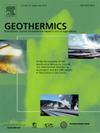Effects of energy storage body parameters on seasonal energy storage performance of borehole thermal energy storage (BTES) system
IF 3.5
2区 工程技术
Q3 ENERGY & FUELS
引用次数: 0
Abstract
Borehole thermal energy storage (BTES) is of great significance for improving energy utilization efficiency and achieving sustainable exploitation of renewable energy. However, the seasonal energy storage performance of BTES are affected by energy storage body parameters and their influence laws are still unclear. In this work, a 3-D numerical model of BTES is developed and validated by the model experiments. Effects of borehole spacing, borehole arrangement, soil stratification and groundwater seepage on the energy storage performance of BTES are numerically investigated. The results show that the energy storage body under different layout forms of borehole exhibits different temperature distributions and thermal diffusion characteristics, and the layout form 2 that the borehole spacing are 4.5, 3.5, and 2.5 m for the interior, middle, and exterior region borehole, respectively has obvious advantages during the energy storage. Compared with the uniform soil and the stratification soil 2 (the geological layers along the depth direction are respectively silty fine sandstone, fine sandstones, mudstone andstone), the stratification soil 1 (the geological layers along the depth direction are respectively sandstone, mudstone, fine sandstone, and silty fine sandstone) not only has larger heat storage and extraction amount, but also has larger energy storage efficiency. Compared to the sequential arrangement form, the staggered arrangement form provides a greater soil volume for energy storage. This leads to lower soil temperatures after heat storage and higher soil temperatures after heat extraction. Moreover, the staggered arrangement form results in larger overall heat storage and extraction capacities, as well as a greater heat storage amount per unit volume. The seepage is unfavorable to the seasonal energy storage of BTES, and the greater the seepage velocity, the more heat is carried to downstream by the seepage, causing heat loss and reduction of energy storage efficiency. Additionally, a small increase in the seepage angle can enhance the heat transfer effect of seepage, and thus the energy storage efficiency can be obviously improved.
蓄能体参数对井内储热系统季节性蓄能性能的影响
钻孔储热对于提高能源利用效率,实现可再生能源的可持续开发具有重要意义。然而,BTES的季节性储能性能受到储能体参数的影响,其影响规律尚不清楚。本文建立了BTES的三维数值模型,并通过模型实验进行了验证。通过数值模拟研究了钻孔间距、钻孔布置、土壤分层和地下水渗流对BTES蓄能性能的影响。结果表明:不同井眼布置形式下的储能体表现出不同的温度分布和热扩散特征,井眼内、中、外区域井眼间距分别为4.5、3.5和2.5 m的布置形式2在储能过程中具有明显的优势;与均匀土和分层土2(沿深度方向的地质层分别为粉质细砂岩、细砂岩、泥岩和砂岩)相比,分层土1(沿深度方向的地质层分别为砂岩、泥岩、细砂岩和粉质细砂岩)不仅具有更大的蓄热量和抽提量,而且具有更大的储能效率。与顺序排列形式相比,交错排列形式为蓄能提供了更大的土壤体积。这导致储热后土壤温度降低,热提取后土壤温度升高。此外,交错排列形式导致更大的整体蓄热和抽热能力,以及更大的单位体积蓄热量。渗流不利于BTES的季节性蓄能,渗流速度越大,渗流向下游输送的热量越多,造成热量损失,降低蓄能效率。此外,渗流角的小幅增大可以增强渗流的换热效果,从而可以明显提高蓄能效率。
本文章由计算机程序翻译,如有差异,请以英文原文为准。
求助全文
约1分钟内获得全文
求助全文
来源期刊

Geothermics
工程技术-地球科学综合
CiteScore
7.70
自引率
15.40%
发文量
237
审稿时长
4.5 months
期刊介绍:
Geothermics is an international journal devoted to the research and development of geothermal energy. The International Board of Editors of Geothermics, which comprises specialists in the various aspects of geothermal resources, exploration and development, guarantees the balanced, comprehensive view of scientific and technological developments in this promising energy field.
It promulgates the state of the art and science of geothermal energy, its exploration and exploitation through a regular exchange of information from all parts of the world. The journal publishes articles dealing with the theory, exploration techniques and all aspects of the utilization of geothermal resources. Geothermics serves as the scientific house, or exchange medium, through which the growing community of geothermal specialists can provide and receive information.
 求助内容:
求助内容: 应助结果提醒方式:
应助结果提醒方式:


